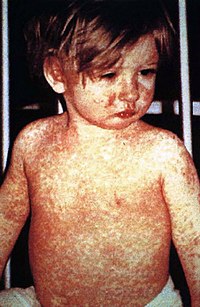
Photo from wikipedia
A 19-year-old male smoker was seen for a red, swollen, left fifth toe and heel pain after stepping on a rock. He was treated for presumed cellulitis. One month later… Click to show full abstract
A 19-year-old male smoker was seen for a red, swollen, left fifth toe and heel pain after stepping on a rock. He was treated for presumed cellulitis. One month later he visited an emergency room for persistent fifth toe pain and erythema with a new ulcer near the heel. He was again treated for cellulitis and referred to podiatry, who observed two plantar puncture wounds and three ischemic-appearing lesions on his fifth toe (Panel A). Given a smoking history, thromboangiitis obliterans was suspected; however, osteomyelitis or melanoma were additionally considered, and a biopsy was recommended. The patient did not comply and weeks later was admitted for pain and presumed infection to an outside hospital. An ankle/brachial index was normal, but ultrasonography revealed decreased velocities in his left peroneal artery. Thromboangiitis obliterans was again suspected and the patient was discharged home. Despite abstinence from tobacco, he failed to improve and was referred to vascular medicine, where his calcaneal surface revealed a granular ulceration with an exophytic, friable bleeding plaque (Panel B). He also had an ulcerated left fifth toe with exposed bone, complete loss of the nail, and a friable bleeding nodule (Panel C). Peripheral pulses and Allen test were normal. Plain film radiography, computed tomography (CT) and magnetic resonance imaging (MRI) of his foot excluded infection. Biopsies of the toe and heel ulcer revealed dermal proliferation of epithelioid to spindled tumor cells with enlarged vesicular nuclei and dense eosinophilic cytoplasm admixed with neutrophils and eosinophils. These findings and immunohistochemical staining supported the diagnosis of pseudomyogenic hemangioendothelioma. Additional images (CT of chest, abdomen, and pelvis) revealed bilateral lung nodules. The patient underwent left fifth toe amputation, sharp dissection of the heel ulcer and wedge resection of a lung nodule that confirmed metastatic involvement. He began chemotherapy with everolimus (a kinase inhibitor) for metastatic disease. Pseudomyogenic hemangioendothelioma is a rare, painful, vascular neoplasm of low-grade malignancy. It commonly presents as superficial or deep skin nodules, solitary or multifocal, involving the dermis, subcutis, skeletal muscle, and bone.1 It has a proclivity for younger males and lower limbs but can be found in the upper limbs, trunk, head or neck.2 It usually displays indolent behavior but, like our case, aggressive metastases are reported.3 Pseudomyogenic hemangioendothelioma can be diagnostically challenging and confused with sarcomatous tumors or other disorders, as noted in our patient. Pseudomyogenic hemangioendothelioma – A rare vascular tumor
Journal Title: Vascular Medicine
Year Published: 2019
Link to full text (if available)
Share on Social Media: Sign Up to like & get
recommendations!